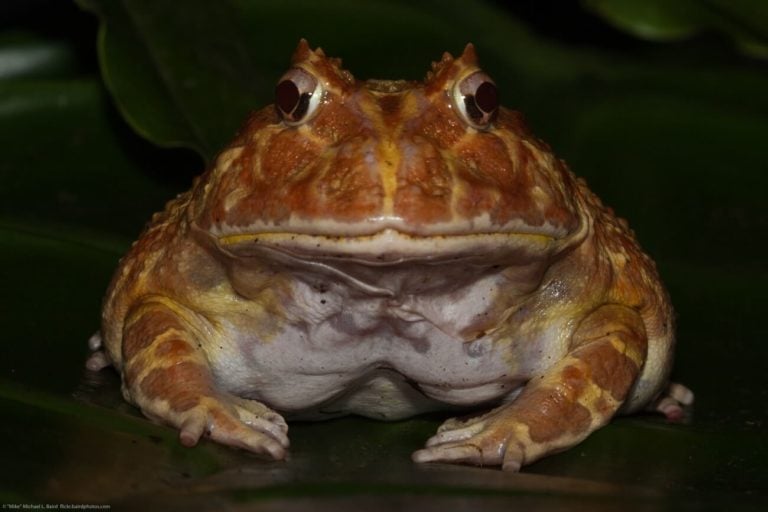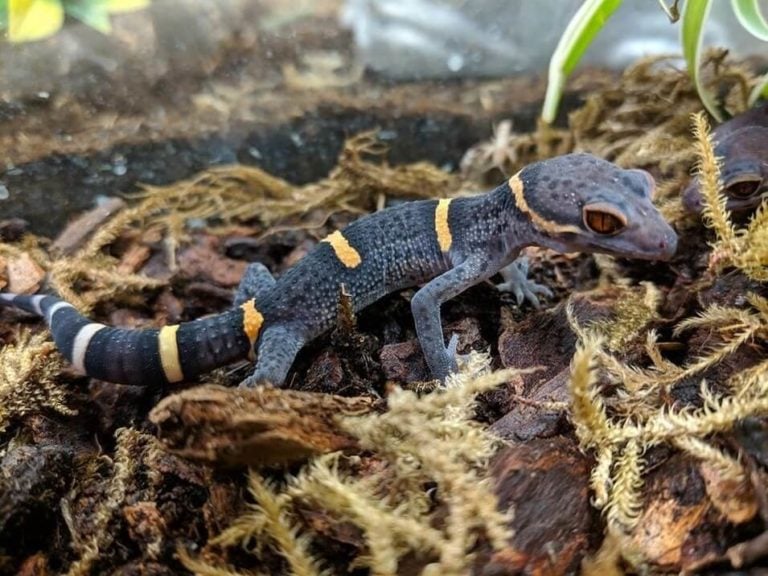Fire skinks are an incredibly unique reptile that can make great pets for owners of all experience levels. These interesting-looking lizards are not only fun to observe, but easy to care for as well!
However, even the most beginner-friendly reptile needs certain conditions in order to thrive.
This guide will teach you the fundamentals of fire skink care. We go over habitat setup, diet, lifespan, and much more!
Table of Contents
Species Summary
The fire skink (Lepidothyris fernandi) is also sometimes known as the Togo fire skink, true fire skink, or African fire skink. This stunning reptile can be found in the forest and woodland areas of West African countries such as Ghana, Togo and Benin.
Because fire skink care is a fairly straightforward process, they’re a really good choice for beginning owners. Their mellow temperament and gorgeous coloring makes them a popular choice for reptile enthusiasts.
Appearance & Colors
If you’re looking for a reptile with stunning visual appeal, then the fire skink is one to consider.
This beautiful little skink has a body color that can range from black to white to silver. However, it’s the bright red scales that give the African fire skink its name and its stunning coloration.
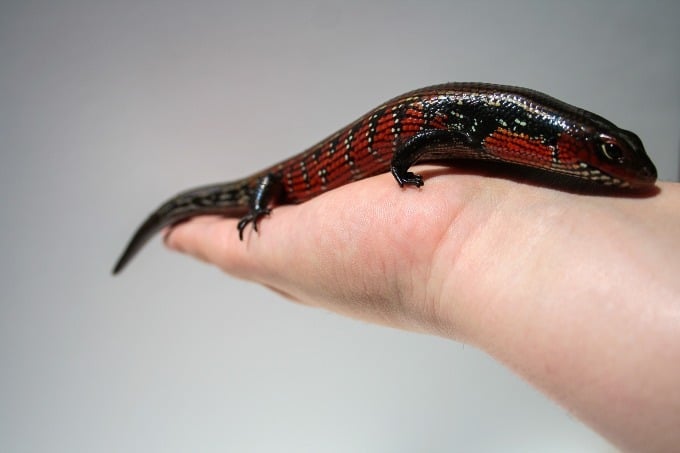
Black specks and white stripes can be found intermingled with the fiery, red scales. The back of the skink is usually a lovely golden color that complements the red of the scales.
Like some other species of reptiles, fire skinks may exhibit a slight color change. This color change is usually due to mood or environment, and is typically nothing to worry about.
Fire skinks have the typical “skink” shape with a long square body, sturdy legs. and thick tails. This stocky build really adds to their overall appeal!
Lifespan
The average fire skink lifespan is between 15 and 20 years. This makes them a great choice for owners who want to build a strong bond and have their pet for quite a while!
Expert Tip: Of course, the lifespan of an African fire skink can be strongly influenced by the quality of care they receive. A good habitat setup, nutritious diet, and careful handling go a long way.
Average Size
The typical size of a fire skink is 14 to 15 inches in length for males, and a few inches shorter for females. Hatchlings are usually around two inches long and will reach their full size in about a year.
The main factors that can impact their size are care, genetics, and the manner in which they were bred. Buying your reptiles from trustworthy and knowledgeable sellers will increase the chance of you owning a big and healthy fire skink.
Fire Skink Care
Fire skink care is pretty easy compared to other pet lizards. However, they still need to have certain basic requirements met.
If you’re going to commit to caring for one of these beauties, then you’ll have to make sure that their enclosure has proper temperature, lighting and humidity levels. Your African fire skink is also going to need a healthy, nutritious diet and proper handling.
For the health and happiness of your pet, the enclosure needs to be immaculately clean as well. Wipe down dirty areas, scoop up messes from the substrate, and replace the substrate often to prevent mold and mildew build-up.
Being consistent about addressing the points above will help you have an enjoyable and long-lasting relationship with your pet!
Tank Size
Making sure that you keep them in the correct tank size will go a long way towards ensuring the health and happiness of your fire skink.
We recommend using a glass 40-50 gallon tank. It’s also better for this species if the enclosure has more horizontal space than vertical space.
Expert Tip: Never put two male African fire skinks together in the same enclosure. They can become very aggressive and will often fight to the death.
It’s alright to put two females together in the same enclosure, but they will need to have plenty of space. If you have a big enough enclosure, you will be able to house a male and several females together.
Habitat Setup
It’s important to think everything through before you start putting together the habitat setup for your fire skink.
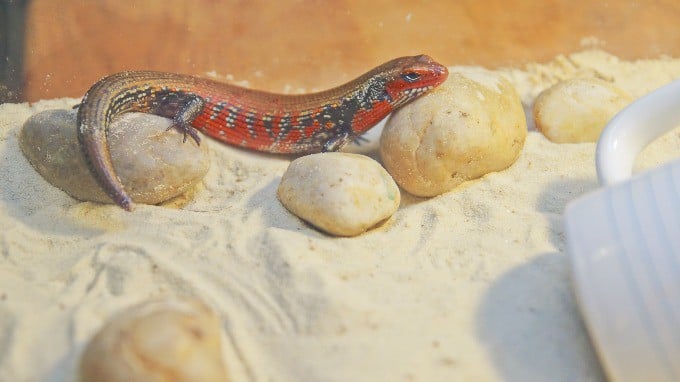
These lizards like to burrow and hide, so providing habitat enhancers like logs, driftwood pieces, plants and reptile hides is very important. A habitat without these will lead to your fire skink feeling unsafe and vulnerable.
Because these reptiles will want to burrow, choosing the right substrate is key as well. We suggest using a combination of clean soil, cypress mulch and sphagnum moss. Remember to top it all off with a layer of some type of leaf litter.
Expert Tip: Never use coconut bark. It can cause a dangerous impaction if it’s ingested!
Temperature & Lighting
Your fire skink, like all reptiles, is not able to internally regulate its body temperature. This is why it is going to be very important to create some kind of gradient heating set-up in the enclosure.
Gradient heating is basically when you create an area for basking where it will be warmer and a cooler area for relaxing and bringing down the body temperature.
The best way to do this is to put the warmer area on one side of the enclosure and the cooler section on the other side. These are often referred to as the ambient temperature side, and the basking side.
Here are the temperatures to remember for each of these areas:
- The ambient temperature within the tank should be between 84 and 86 degrees Fahrenheit.
- Keep the basking area somewhere between 92 and 96 degrees Fahrenheit.
Expert Tip: As far as nighttime temperatures go, letting the tank temperature go as low as 70 degrees Fahrenheit is fine.
Make sure that you put several thermometers in different areas of the tank. This will help to ensure that the temperature inside the enclosure is always within acceptable limits.
An under-the-tank heater on the warm end of the tank is helpful, and dome lights can be useful as well. Never put the lights directly into the tank. Doing so can cause burns, or the heat in the enclosure may get too high.
Reptiles that do not get enough UVA exposure may develop metabolic bone disease. Using a 40 watt reptile bulb is often enough to give your skink enough UVA light.
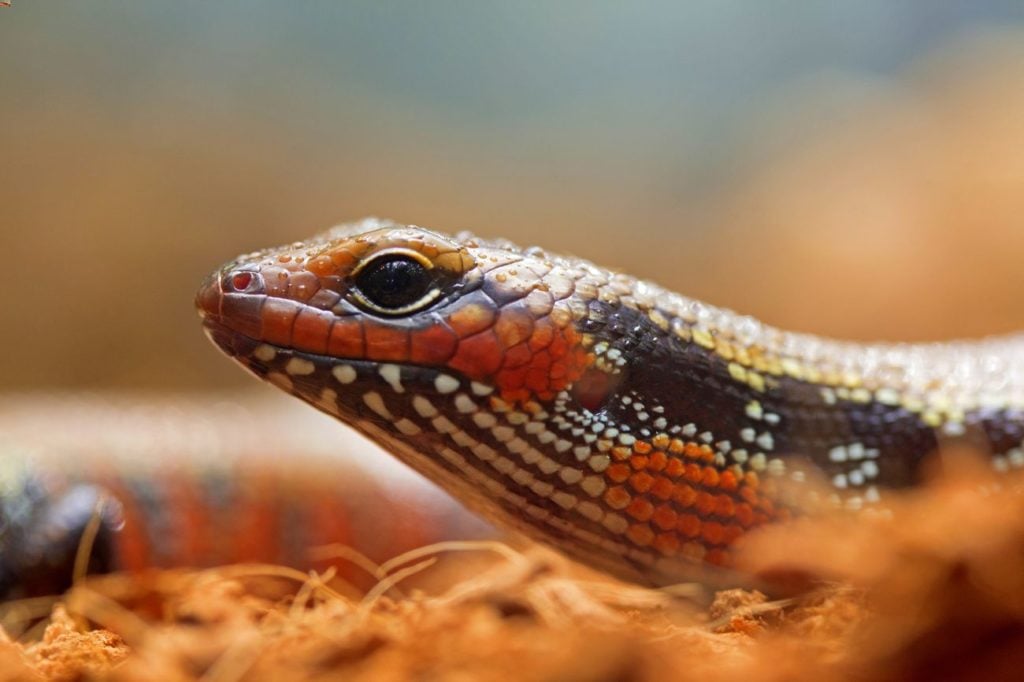
In most cases, supplementing with UVB lighting is optional because fire skinks will usually get what they need from their dusted food. We will discuss food dusting a bit later on.
In the spring and summer months, your skink will benefit from 10 to 12 hours of daylight. In the cooler months, they prefer 8 to 10 hours of daylight.
Humidity
Keeping the correct level of humidity inside your skink’s enclosure is going to be quite important. Fire skinks need humidity levels between 60 and 70 percent in their habitat.
Misting the enclosure two times each day will ensure that the humidity level remains in this range. If the substrate of the enclosure always remains moist (not wet) then it’s alright if the surface humidity drops to 40 percent sometimes.
Expert Tip: Always use an accurate and reliable hygrometer to check the humidity levels within the tank. Purchasing one is money well-spent.
Water
Your fire skink is not going to require anything fancy when it comes to water sources within the habitat. They get most of the water they need from their prey or from the water droplets formed during misting.
While it’s not necessary to provide a water dish, adding a very shallow water container can enhance the humidity level. Some people have kept these lizards in paludariums, but that’s not necessary.
Fire Skink Food & Diet
One reason why fire skink care is so simple (making them great pet reptiles for beginners), is that they don’t have a lot of fussy food requirements.
Live food items like crickets, waxworms, butterworms and mealworms are great options. Pinkie mice can be given on occasion too (although it’s not necessary).
No matter what you give your African fire skink, make sure to dust it with a calcium and vitamin powder prior to feeding time. Dusting provides extra nutrition and can prevent metabolic bone disease.
Feeding your skink 3-5 insects every three days is the generally recommended feeding schedule. This will allow them to receive the necessary nutrients without overeating.
Potential Health Issues
Fire skinks are not known to be overly delicate pets, but they are prone to a few health issues that you should be aware of.
Most of the health issues you may encounter have to do with nutrition or an unclean enclosure. The great thing about this is that it gives you a lot of control when it comes to keeping them healthy. Being consistent with cleaning allows you to drastically reduce the chance of them getting sick!
Fire skinks are susceptible to ticks, mites and bacterial infections. These are all issues that can stem from an unclean enclosure or introducing a contaminated item (food, decorations, etc.) into their habitat.
Expert Tip: Like all reptiles, they can get metabolic bone disease from a lack of proper nutrition or UVA/UVB lighting. In most cases, your African fire skink will get what it needs from its food, but poor feeding habits can make them more apt to suffer from this preventable condition.
Behavior & Temperament
The fire skink has a fairly calm temperament that can make it a good match for novice reptile owners. They are active burrowers and will spend a fair bit of time staying hidden under an appropriate substrate.
Since fire skinks are diurnal, you will notice that they are the most active during the day. This is a great time to watch them bask, burrow or just hang out!
While it’s true that fire skinks have a pretty even temperament, they will (like all reptiles) bite if provoked. This isn’t something you’ll have to worry much about, but it’s worth pointing out that it is a possibility.
Handling Them
Fire skinks don’t love to be handled, but you can get them used to it. This requires being consistent and gradually handling them over time until they adjust.
The main challenge when it comes to handling this species is that they are very squirmy, and they can easily escape from your grasp. With this in mind, it is very important to hold them in a place where they can’t get hurt if they do make the great escape.
Never pick up your African fire skink by the tail, and always supervise children when they’re around your pet (you never know what kids will do).
Conclusion
Once you know the basics, fire skink care is really simple. These reptiles are a piece of cake to own and a bunch of fun to observe!
With their calm temperament and beautiful colors, it’s no wonder why this is such a popular pet lizard.
Hopefully you enjoyed this care sheet and feel more prepared to own these reptiles as a result. We can’t recommend them enough!

